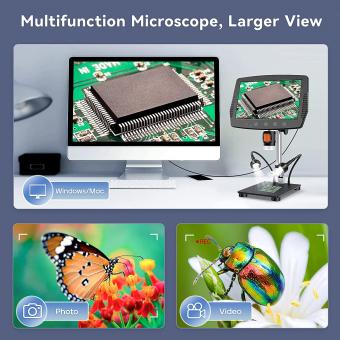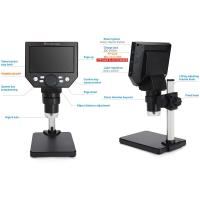What Do Germs Look Like Under A Microscope ?
Germs, also known as microorganisms, can have various appearances under a microscope depending on their type. Bacteria, for example, are single-celled organisms that can appear as tiny rods, spheres, or spirals. They may also have different structures such as flagella for movement. Viruses, on the other hand, are much smaller than bacteria and can only be seen using an electron microscope. They typically appear as small, round particles with various shapes and structures. Fungi, including molds and yeasts, can have different forms as well, ranging from thread-like structures to clusters of spores. Overall, the appearance of germs under a microscope can vary greatly depending on their classification and specific characteristics.
1、 Bacterial morphology and structure under a microscope
Bacterial morphology and structure under a microscope can vary greatly depending on the type of bacteria being observed. Generally, bacteria are single-celled microorganisms that come in a variety of shapes and sizes. The most common bacterial shapes include cocci (spherical), bacilli (rod-shaped), and spirilla (spiral-shaped).
When observed under a microscope, cocci bacteria appear as round or oval cells. They can occur in clusters (staphylococci) or chains (streptococci). Bacilli bacteria, on the other hand, appear as elongated cells with a cylindrical or rod-like shape. They can be found singly or in chains. Spirilla bacteria are characterized by their spiral or corkscrew shape, and they can be quite long and flexible.
In addition to their shape, bacteria also possess various structures that can be observed under a microscope. These structures include a cell wall, cell membrane, cytoplasm, and genetic material (DNA). Some bacteria may also have additional features such as flagella for movement, pili for attachment, or capsules for protection.
It is important to note that advancements in microscopy techniques have allowed for more detailed observations of bacterial morphology and structure. For instance, electron microscopy provides higher magnification and resolution, allowing scientists to study the fine details of bacterial cells. This has led to the discovery of additional structures within bacteria, such as nanowires or appendages involved in electron transfer.
Furthermore, recent studies have also focused on understanding the three-dimensional structure of bacteria using techniques like cryo-electron tomography. This approach allows scientists to visualize bacteria in their native state, providing insights into their spatial organization and interactions with their environment.
Overall, the morphology and structure of bacteria under a microscope can vary greatly, and ongoing research continues to uncover new details about these fascinating microorganisms.

2、 Viral morphology and structure under a microscope
Germs, including viruses, can have diverse morphologies and structures when observed under a microscope. However, it is important to note that not all germs are visible under a light microscope, as some are too small to be resolved by this technology. Viruses, in particular, are much smaller than bacteria and can only be visualized using an electron microscope.
Viruses are composed of genetic material, either DNA or RNA, surrounded by a protein coat called a capsid. Some viruses have an additional outer envelope made up of lipids. The shape of the capsid can vary greatly among different viruses. For example, some viruses have a spherical shape, such as the adenovirus, while others have a helical shape, like the tobacco mosaic virus. There are also complex viruses with more intricate structures, such as the bacteriophage, which infects bacteria.
Advancements in microscopy techniques have allowed scientists to gain a deeper understanding of viral structures. Cryo-electron microscopy (cryo-EM) has revolutionized the field by enabling the visualization of viruses at near-atomic resolution. This technique involves freezing the virus in a thin layer of ice and imaging it using an electron microscope. Cryo-EM has provided detailed insights into the three-dimensional structures of various viruses, helping researchers understand their mechanisms of infection and aiding in the development of antiviral therapies.
It is worth mentioning that the field of virology is constantly evolving, and new discoveries about viral morphology and structure are being made. With the advent of advanced microscopy techniques and computational methods, scientists are now able to study viruses in unprecedented detail, leading to a better understanding of their behavior and potential vulnerabilities.

3、 Fungal morphology and structure under a microscope
Fungal morphology and structure under a microscope can vary greatly depending on the specific type of fungus being observed. Fungi are eukaryotic organisms that can be found in various environments, including soil, water, and even on the human body. When viewed under a microscope, fungi typically appear as thread-like structures called hyphae.
Hyphae are the basic building blocks of fungi and can be either septate or nonseptate. Septate hyphae are divided into distinct cells by cross-walls called septa, while nonseptate hyphae lack these divisions. The hyphae of some fungi can also be branched, forming a complex network known as mycelium.
Fungal spores are another important feature that can be observed under a microscope. Spores are reproductive structures that allow fungi to spread and colonize new areas. They come in various shapes, sizes, and colors, depending on the fungal species. Some common types of spores include conidia, ascospores, and basidiospores.
In addition to hyphae and spores, other structures such as fruiting bodies or reproductive structures may also be visible under a microscope. These structures, such as mushrooms or molds, are formed by certain types of fungi during their reproductive phase.
It is important to note that the field of mycology, which focuses on the study of fungi, is constantly evolving. New research and advancements in microscopy techniques have allowed scientists to gain a deeper understanding of fungal morphology and structure. Therefore, the latest point of view may include more detailed observations of fungal structures, as well as the use of advanced imaging techniques to study their intricate features.

4、 Protozoan morphology and structure under a microscope
Protozoa are single-celled eukaryotic microorganisms that can be found in various environments, including soil, water, and the bodies of plants and animals. When observed under a microscope, the morphology and structure of protozoa can vary greatly depending on the species. However, there are some common characteristics that can be observed.
Protozoa typically have a well-defined cell membrane that encloses their cytoplasm. Some species may possess a rigid outer covering called a pellicle, which provides structural support. Within the cytoplasm, various organelles can be observed, including a nucleus, mitochondria, and vacuoles. The nucleus contains the genetic material of the protozoan and is responsible for controlling cellular functions.
Many protozoa have appendages called cilia or flagella, which are used for locomotion. Cilia are short, hair-like structures that cover the surface of the cell and beat in coordinated waves, allowing the protozoan to move. Flagella, on the other hand, are longer and fewer in number, providing propulsion through a whip-like motion.
Some protozoa also possess specialized structures for feeding and defense. For example, some species have oral grooves or cytostomes that allow them to ingest food particles. Others may have contractile vacuoles that help regulate water balance within the cell.
It is important to note that the field of protozoan morphology and structure is constantly evolving as new research and technological advancements are made. Therefore, the latest point of view may include more detailed observations of specific organelles, molecular studies, and the use of advanced imaging techniques such as electron microscopy to explore the ultrastructure of protozoa. These advancements contribute to a better understanding of the diversity and complexity of protozoan morphology and structure.







































